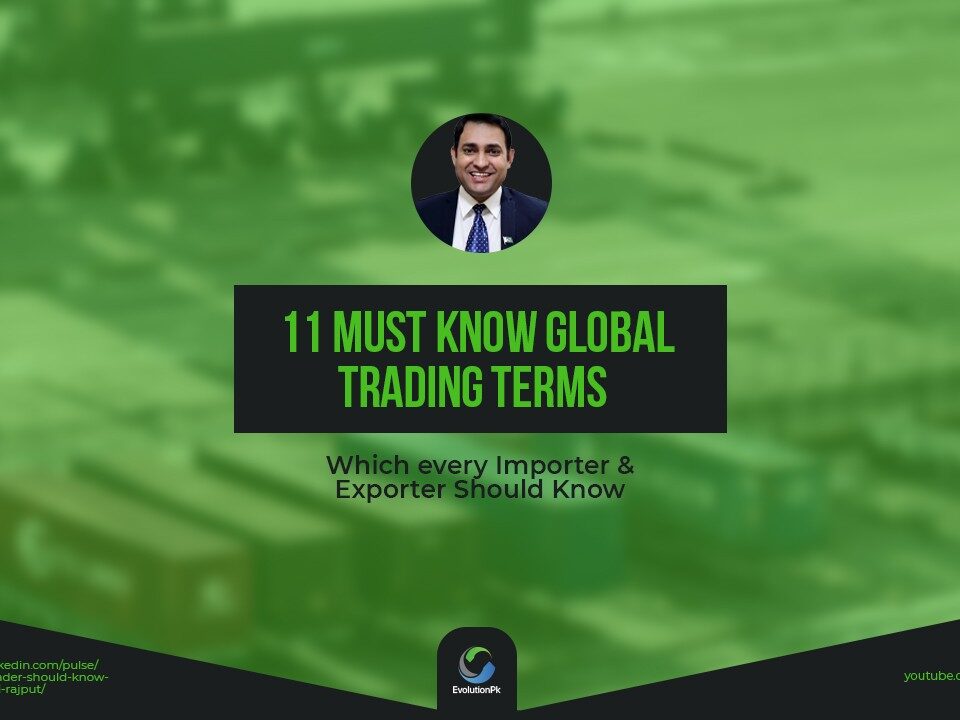
Irrevocable Letter of Credit (ILOC)
August 31, 2022
Difference b/w a bank guarantee & a letter of credit?
September 2, 2022𝐄𝐟𝐟𝐞𝐜𝐭𝐬 𝐨𝐟 𝐈𝐦𝐩𝐨𝐫𝐭𝐬 𝐚𝐧𝐝 𝐄𝐱𝐩𝐨𝐫𝐭𝐬 𝐨𝐧 𝐭𝐡𝐞 𝐏𝐚𝐤𝐢𝐬𝐭𝐚𝐧 𝐄𝐜𝐨𝐧𝐨𝐦𝐲
Consumers are accustomed to finding goods from all over the world at their neighborhood grocery stores and retail outlets in today’s global economy. Consumers have more options because of imports from other countries. Imports also provide consumers ease of buying those products which domestically are not produced.
However import’s role in a country’s trade balance can be distorted and its currency devalued if there are too many imports relative to its exports, which are goods delivered from that country to another country. Because the value of a currency is one of the main factors of a country’s economic success and its gross domestic product, it can have a significant impact on the residents’ day-to-day lives (GDP).
A nation must maintain a healthy balance between imports and exports. A country’s import and export activities can have an impact on its GDP, exchange rate, degree of inflation, and interest rates.
𝐆𝐫𝐨𝐬𝐬 𝐃𝐨𝐦𝐞𝐬𝐭𝐢𝐜 𝐏𝐫𝐨𝐝𝐮𝐜𝐭 𝐈𝐦𝐩𝐚𝐜𝐭
A nation’s overall economic activity is broadly measured by its gross domestic product (GDP). Exports and imports have a significant role in the expenditure approach to computing GDP.
The GDP calculation is done as follows:
GDP=C+I+G+(X−M) 𝐰𝐡𝐞𝐫𝐞:
C=Consumer spending on goods and services
I=Investment spending on business capital goods
G=Government spending on public goods and services
X=Exports
M=Imports
Net exports are determined by subtracting imports from exports, the net exports figure is positive when exports outpace imports. This shows the existence of a trade surplus in that nation. The net exports figure is negative when exports are lower than imports. This suggests that there is a trade deficit in the country.
A country’s economic growth is aided by a trade surplus. When there are more exports, it indicates that a nation’s factories and industrial facilities are producing at a high rate and that a larger workforce is needed to keep these factories running. A company’s high level of exports also translates into a flow of money into the nation, which encourages consumer spending and aids in economic expansion.
𝐀𝐬 𝐚 𝐂𝐢𝐭𝐢𝐳𝐞𝐧 𝐇𝐨𝐰 𝐈𝐦𝐩𝐨𝐫𝐭𝐬 𝐀𝐧𝐝 𝐄𝐱𝐩𝐨𝐫𝐭𝐬 𝐀𝐟𝐟𝐞𝐜𝐭 𝐘𝐨𝐮
When a nation imports products, money is expended from that nation. The exporters are foreign organizations, and the importers are local businesses that pay the exporters. An expanding economy and strong domestic demand are both indicated by high import levels. It is even more advantageous for a nation if these imports mostly consist of productive assets like machinery and equipment since, over time, productive assets will raise the productivity of the economy.
An economy that is growing in both exports and imports is considered to be in good health. This often denotes robust economic growth and a long-term surplus or deficit in international commerce. If exports are increasing but imports have sharply decreased, it can mean that foreign economies are doing better.
In contrast, if exports plunge while imports soar, this can be a sign that the internal economy is doing better than the markets at home.
For instance, Pakistan’s trade imbalance typically increases during periods of rapid economic expansion. At this point, more goods are imported into Pakistan than are exported. Pakistan continues struggling to have productive economies in the world
However, generally speaking, a country’s exchange rate, or the rate at which its domestic currency is valued in relation to other currencies, can be negatively impacted by an increase in imports and a widening trade deficit.
𝐈𝐦𝐩𝐚𝐜𝐭 𝐨𝐧 𝐈𝐧𝐭𝐞𝐫𝐞𝐬𝐭 𝐑𝐚𝐭𝐞𝐬 𝐚𝐧𝐝 𝐈𝐧𝐟𝐥𝐚𝐭𝐢𝐨𝐧
The main way that inflation and interest rates have an impact on imports and exports is through the currency rate. Usually, increased inflation results in higher interest rates.
It is unclear whether this causes the currency to strengthen or weaken.
According to conventional currency theory, a currency will lose value in comparison to another currency if its inflation rate is higher and its interest rate is higher. The difference in interest rates between two countries equals the anticipated change in their exchange rates, according to the uncovered interest rate parity hypothesis. Therefore, if there is a two percent difference in interest rates between two nations, the higher-interest-rate nation’s currency should depreciate two percent versus the lower-interest-rate nation’s currency.
However, since the global credit crisis of 2008–2009, low-interest rates have largely prevailed, worldwide leading investors and speculators to seek out the higher yields provided by currencies with higher interest rates. The result has been a strengthening of currencies with increased interest rates.
Of course, this strategy is typically limited to the stable currencies of countries with sound economic fundamentals since these investors must have confidence that greater returns would not be negated by currency depreciation.
Exports and the trade balance may suffer as a result of a stronger home currency. A rise in inflation can also have an effect on exports by directly affecting the cost of inputs like labor and materials. These greater expenses may significantly affect how competitively priced exports are in the context of global trade.
𝐅𝐢𝐧𝐚𝐧𝐜𝐢𝐚𝐥 𝐑𝐞𝐩𝐨𝐫𝐭𝐬
The finest source of data to track imports and exports is a country’s merchandise trade balance report. The majority of the big nations publish this report every month.
Trade balance data are typically published weekly by the Pakistan Bureau of Statistics (https://www.pbs.gov.pk).
These reports include facts on the top trading partners, the biggest product categories for imports and exports, and historical patterns. They also feature a variety of information.
Writer: Shakir Ali Rajput
Email: shakir.ali@evolution.pk


